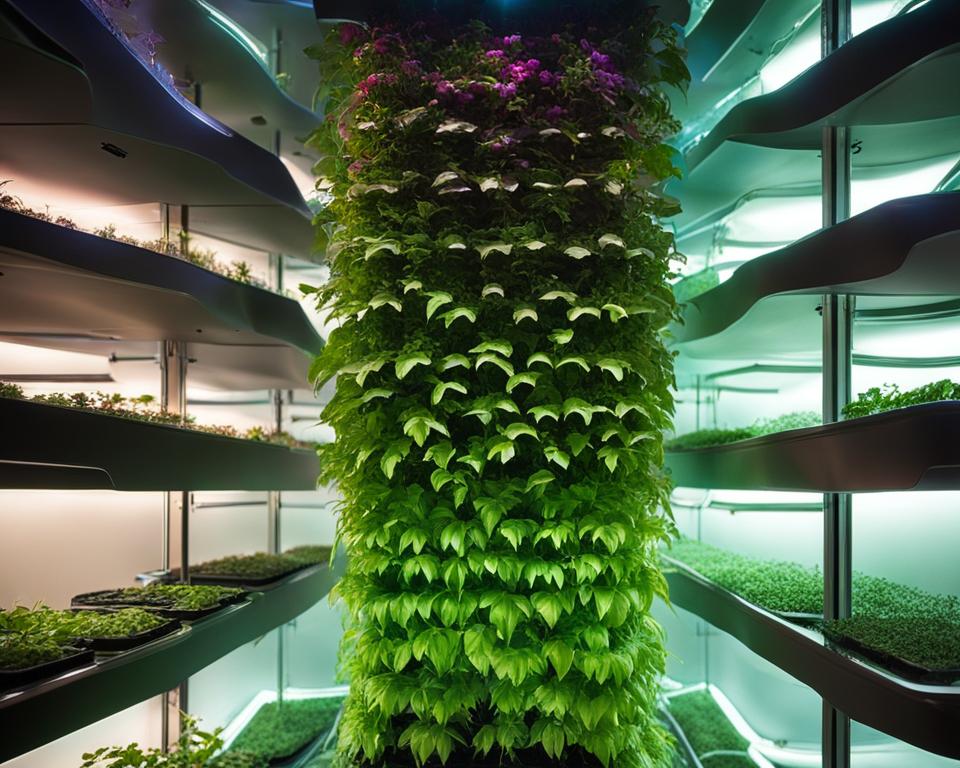I have always been fascinated by innovative gardening techniques, and one that has caught my attention recently is vertical hydroponic gardening. This unique method combines the principles of hydroponics and vertical farming to create a space-saving and efficient way to grow crops in urban areas where space is limited.
Vertical hydroponic gardening systems have a long history, with ancient civilizations like the Babylonians practicing vertical gardening. Today, modern systems offer numerous advantages, including compact design, soilless growth, increased productivity, and minimal maintenance.
In this article, we will explore the world of vertical hydroponics, discussing what it is, its advantages and disadvantages, how it works, and even how to set up a simple vertical hydroponic tower at home. Whether you’re a seasoned gardener looking for a new challenge or a city dweller seeking a sustainable way to grow your own food, vertical hydroponic gardening is definitely worth trying.
Key Takeaways:
- Vertical hydroponic gardening combines hydroponics and vertical farming to grow crops in stacked layers.
- It is especially beneficial in urban areas with limited space for traditional gardening.
- Advantages include compact design, soilless growth, increased efficiency, and minimal maintenance.
- Challenges include water flow and light supply issues.
- Vertical hydroponics offers a sustainable and efficient approach to growing food.
What Is Vertical Hydroponics?
Vertical hydroponics is a fascinating combination of hydroponics and vertical farming, allowing for the cultivation of crops in vertically stacked layers. This innovative method has its roots in ancient history, with the Babylonians building tiered gardens as far back as 600-500 BC. In modern times, vertical hydroponics has gained popularity as an ideal solution for urban areas where floor space is limited.
One of the main advantages of vertical hydroponics is its compact and space-saving design. By utilizing vertical space, growers can maximize their productivity and grow more crops in a small indoor area. In addition to saving space, vertical hydroponics eliminates the need for soil, reducing weed growth and making maintenance easier. This method of cultivation also allows for precise control over nutrient delivery and environmental conditions, resulting in optimal growth and productivity.
Vertical hydroponic systems can be designed with various techniques, such as the nutrient film technique (NFT), where a thin stream of nutrient-rich water is continuously circulated over the roots of the plants. These systems can be tailored to suit a wide range of crops, including leafy greens, herbs, vegetables, and even some fruits. With the right nutrient mix and proper lighting, vertical hydroponics can offer high efficiency and productivity, making it an attractive option for both commercial and home growers.
Advantages of Vertical Hydroponics
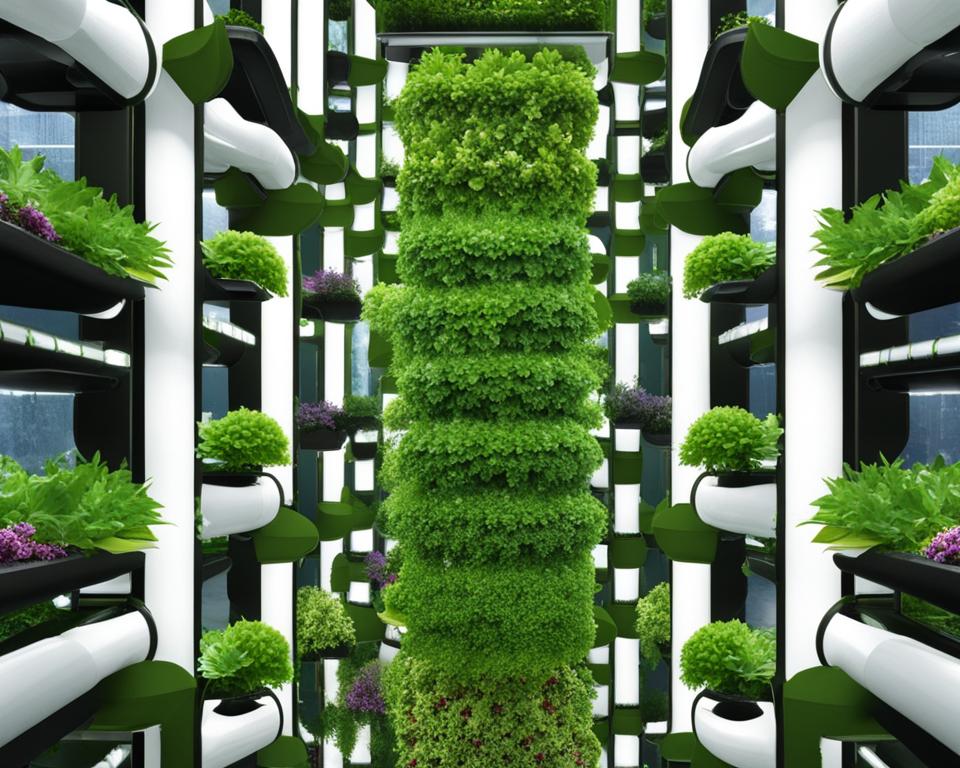
Vertical hydroponics offers numerous advantages for urban farming and indoor hydroponic systems. Its compact and space-saving design allows individuals to maximize their cultivation potential in small indoor spaces, making it an ideal solution for urban areas with limited available land. By utilizing vertical space, growers can cultivate more plants, increasing their productivity and yield.
The soilless growth characteristic of hydroponics eliminates the need for traditional soil, reducing the growth of weeds and pests. This makes vertical hydroponics a practical and lightweight form of vertical farming, requiring less maintenance and providing a cleaner growing environment.
Vertical hydroponic systems also offer efficiency benefits. By stacking plants vertically, growers can accommodate more plants in the same surface space, optimizing their use of available resources. With the right nutrient mix and proper lighting, these systems can achieve high growth rates and maximize productivity.
Advantages of Vertical Hydroponics
- Compact and space-saving design
- Soilless growth minimizes weed and pest growth
- Increased efficiency and productivity
- Minimizes wastage and maintenance
Additionally, vertical hydroponics systems offer the advantage of closed nutrient and water flow systems that can be automated, minimizing wastage and reducing the need for constant monitoring. These systems contribute to sustainable gardening practices by conserving water and nutrients, making them environmentally friendly alternatives to traditional farming methods.
In summary, the advantages of vertical hydroponics make it a highly attractive option for urban farming and indoor gardening. The compact design, soilless growth, increased efficiency, and minimal maintenance make it an ideal choice for individuals looking to maximize their cultivation potential in limited spaces. With the right setup and management, vertical hydroponic systems provide an innovative and sustainable approach to growing plants.
Disadvantages of Vertical Hydroponics
While vertical hydroponics systems offer numerous advantages, they are not without their challenges. It’s important to consider the potential disadvantages before committing to this method of indoor gardening.
Water Flow Challenges
One of the main challenges in vertical hydroponic systems is ensuring equal water distribution to all plants in stacked systems. Due to the nature of gravity, water tends to flow more easily to the lower layers, potentially leaving the plants in the upper layers undernourished. To overcome this challenge, higher powered pumps and careful design are necessary to create a balanced water flow throughout the system.
Light Supply Issues
In indoor vertical hydroponic systems, providing sufficient light to all plants can be a challenge. Since the plants are stacked vertically, light penetration may be limited, especially for those plants located deeper in the system. Supplemental lighting, such as LED grow lights, may be required to ensure that all plants receive adequate light for photosynthesis.
Resource Intensity
Scaling up vertical hydroponics systems can be resource-intensive. These systems often require higher energy consumption for lighting, as well as continuous monitoring of water flow in closed systems. The input costs associated with vertical hydroponics, including energy bills and maintenance, should be considered before investing in this method of indoor gardening.
| Disadvantages | Solutions |
|---|---|
| Water flow challenges | Use higher powered pumps and design the system for balanced water distribution |
| Light supply issues | Incorporate supplemental lighting, such as LED grow lights, to ensure all plants receive sufficient light |
| Resource intensity | Consider the energy consumption and maintenance requirements before investing in a vertical hydroponics system |
How Does a Vertical Hydroponic System Work?
Vertical hydroponic systems utilize various hydroponic techniques to allow for the efficient cultivation of plants in vertically stacked layers. One commonly used technique is the nutrient film technique (NFT), which involves continuously delivering a thin stream of nutrient-rich water over the plants’ roots. This method ensures that the plants receive a constant supply of nutrients while preventing waterlogging.
In a typical vertical hydroponic tower design, a tube system is used to deliver water to the top layers of the tower. Gravity then allows the water to flow down through the layers, ensuring that each plant receives adequate irrigation. DIY designs often utilize PVC pipes or drainage pipes with drilled holes to house the individual plants, allowing for proper support and nutrient delivery.
Proper lighting is crucial for the success of a vertical hydroponic system, especially in indoor setups. Multiple vertically mounted grow lights are positioned strategically to ensure uniform lighting for all the plants. LED grow lights are commonly used due to their energy efficiency, long lifespan, and ability to provide the specific light wavelengths needed for plant growth.
| Hydroponic Technique | Description |
|---|---|
| Nutrient Film Technique (NFT) | A thin stream of nutrient-rich water is continuously circulated over the plants’ roots, providing a constant supply of nutrients. |
| Deep Water Culture (DWC) | Plants are suspended in a nutrient-rich solution with their roots submerged in water, allowing for direct uptake of nutrients. |
| Aeroponics | Plant roots are suspended in the air, and a fine mist of nutrient solution is periodically sprayed onto the roots, promoting efficient nutrient absorption. |
Vertical hydroponic systems offer a sustainable and space-saving solution for indoor gardening. By utilizing hydroponic techniques like the NFT, growers can optimize nutrient delivery and achieve high productivity in limited spaces. The combination of a well-designed irrigation system, proper lighting, and the selection of suitable hydroponic techniques is key to the success of a vertical hydroponic system.
Benefits of using vertical grow lights
- Uniform lighting: Vertical grow lights ensure that all plants receive equal exposure to light, promoting even growth and development.
- Space efficiency: By positioning the lights vertically, growers can maximize their use of space and accommodate more plants within a limited area.
- Energy efficiency: LED grow lights are known for their energy efficiency and long lifespan, reducing energy consumption and operating costs.
- Customizable light spectrum: Different plant species have varying light requirements. Vertical grow lights allow growers to adjust the light spectrum to match the specific needs of their crops.
Implementing a well-designed vertical hydroponic system with the appropriate hydroponic techniques and proper lighting is essential for successful indoor gardening. By harnessing the benefits of vertical hydroponics and optimizing plant growth conditions, growers can achieve high productivity and maximize the use of limited space.
How To Set Up a Simple Vertical Hydroponic Tower
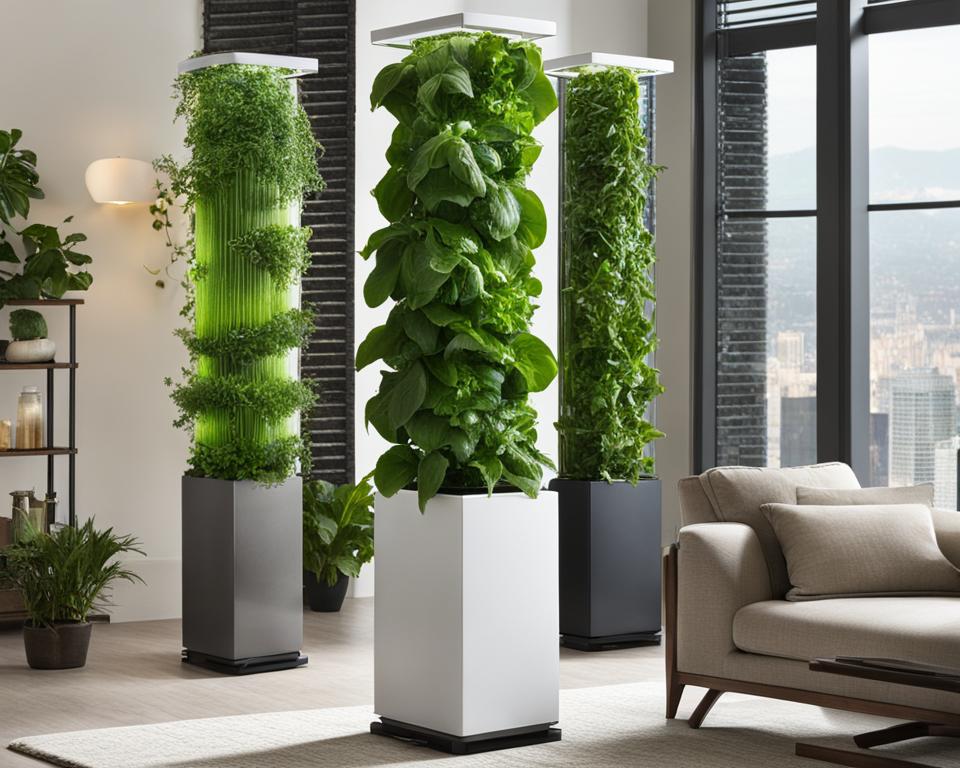
Setting up a simple vertical hydroponic tower is a cost-effective and efficient way to grow your own fresh produce at home. With just a few basic materials and some DIY skills, you can create your own vertical hydroponic system that maximizes space and yields bountiful results.
To start, you will need a large PVC pipe, an end cap, a bucket with a lid, a submersible pump, net pots, vinyl hose, Loctite PVC Epoxy, and LED grow lights. Begin by placing the PVC pipe into the bucket and marking slots for the net cups. These net cups will hold the plants in place as they grow.
Next, create smaller PVC pipes as holders for the net cups. Angle them at 45 degrees, ensuring that each plant has enough space to thrive. Use Loctite PVC Epoxy to secure the net cups and PVC pipes in place.
Once your structure is in place, connect the vinyl hose to the submersible pump. The pump will deliver a nutrient solution to the top of the tower, allowing it to percolate down through the inside of the pipe and feed the plants. Finally, position the LED grow lights above the tower, providing the necessary lighting for optimal plant growth.
Table: Materials and Tools for Setting Up a Simple Vertical Hydroponic Tower
| Materials | Tools |
|---|---|
| Large PVC pipe | Marker |
| End cap | Saw |
| Bucket with a lid | Drill |
| Submersible pump | Loctite PVC Epoxy |
| Net pots | Tape measure |
| Vinyl hose | Scissors |
| Nutrient solution | |
| LED grow lights |
With your simple vertical hydroponic tower set up, you can start growing a wide variety of plants, from leafy greens and herbs to vegetables and even small fruits. This DIY system allows you to take control of your own food production while maximizing space and resources.
Ideal Plants for Vertical Hydroponics
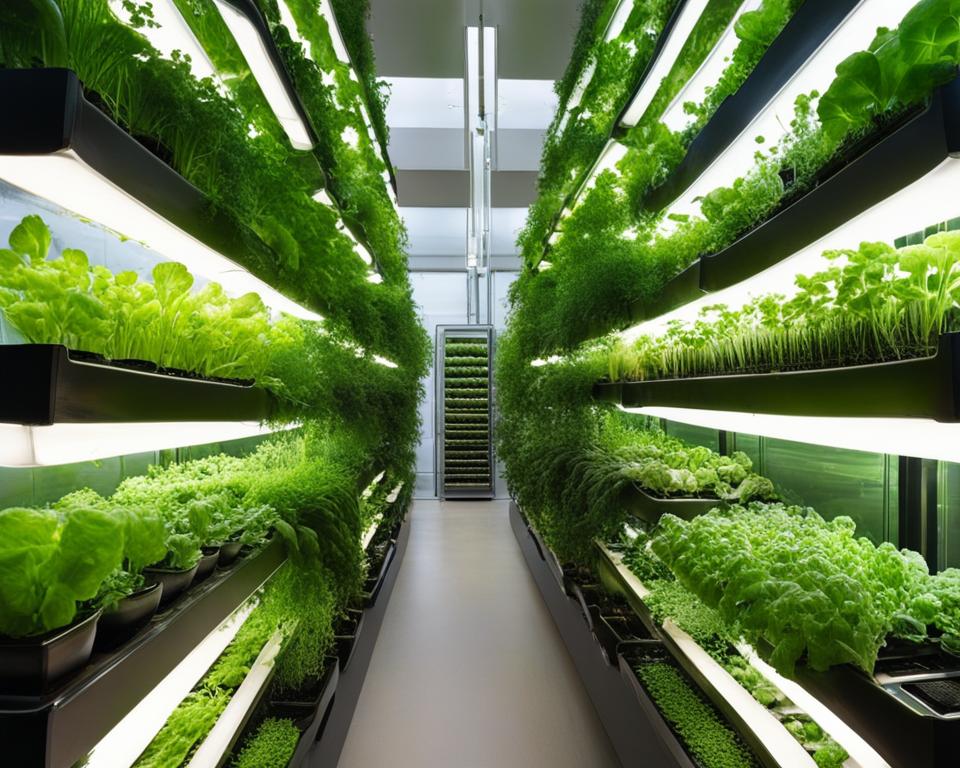
When it comes to vertical hydroponics, there is a wide variety of plants that thrive in this innovative growing system. From leafy greens to herbs, flowers to vegetables, and even fruits, vertical hydroponics offers the perfect environment for their healthy growth.
Leafy Greens
Leafy greens, such as lettuce, kale, chard, mustard greens, collard greens, and spinach, are excellent choices for vertical hydroponics. These fast-growing plants benefit from the precise nutrient delivery and controlled growing conditions offered by this system. With vertical hydroponics, you can enjoy a constant supply of fresh and crispy greens for your salads and meals.
Herbs
Vertical hydroponics is also ideal for growing herbs, which can add flavor and aroma to your dishes. Basil, cilantro, mint, dill, and chives are some popular herbs that thrive in this system. With vertical hydroponics, you can have a continuous supply of fresh herbs right at your fingertips.
Flowers, Vegetables, and Fruits
Vertical hydroponics is not limited to just leafy greens and herbs. You can also grow flowers, vegetables, and even fruits using this system. Some suitable options include cabbage, broccoli, tomatoes, cucumbers, eggplants, peppers, and strawberries. By utilizing vertical space efficiently, you can maximize your yield and enjoy a diverse range of homegrown produce.
| Plants | Type |
|---|---|
| Lettuce | Leafy Green |
| Kale | Leafy Green |
| Chard | Leafy Green |
| Mustard Greens | Leafy Green |
| Collard Greens | Leafy Green |
| Spinach | Leafy Green |
| Basil | Herb |
| Cilantro | Herb |
| Mint | Herb |
| Dill | Herb |
| Chives | Herb |
| Cabbage | Vegetable |
| Broccoli | Vegetable |
| Tomatoes | Vegetable |
| Cucumbers | Vegetable |
| Eggplants | Vegetable |
| Peppers | Vegetable |
| Strawberries | Fruit |
Vertical hydroponics offers a versatile and efficient way to grow a wide range of plants. Whether you’re a fan of leafy greens, herbs, or want to venture into cultivating vegetables and fruits, vertical hydroponics provides the ideal environment for their flourishing growth. With the right nutrient mix and proper lighting, you can enjoy a continuous supply of fresh, healthy produce right in your own home. Embrace the possibilities of vertical hydroponics and explore the world of vertical gardening today.
The Rise of Home Hydroponics
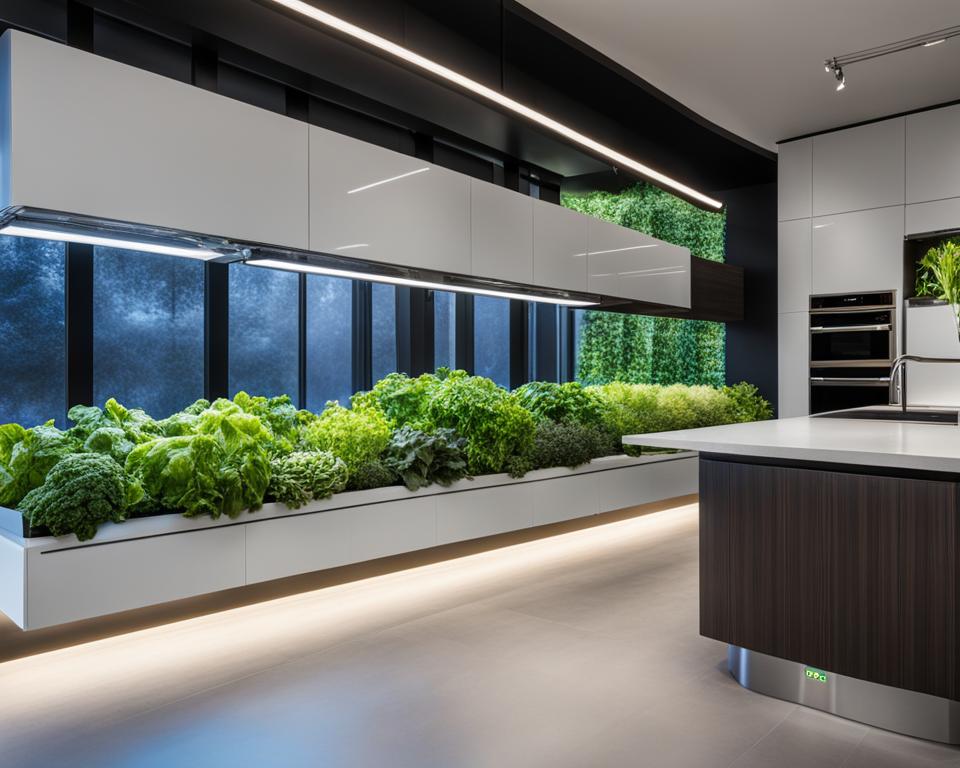
As more people embrace the benefits of indoor gardening, home hydroponics has gained significant popularity. These hydroponic growing systems offer an innovative and space-efficient way to cultivate plants without soil, making it ideal for urban dwellers and those with limited outdoor space. With the increasing interest in sustainable and self-sufficient living, home hydroponics has become a go-to solution for growing fresh produce at home.
A notable player in the home hydroponics market is Rise Gardens, providing sleek and high-tech solutions for indoor gardening. Their systems, like the Rise Garden, combine elegant design with practical functionality, allowing individuals to easily grow a variety of plants right in their own homes. With features such as LED grow lights, built-in water reservoirs, and automated nutrient delivery systems, Rise Gardens has made hydroponic gardening accessible to beginners and experienced gardeners alike.
Another popular name in the home hydroponics industry is AeroGarden. Their compact and user-friendly systems offer hassle-free indoor gardening, allowing anyone to grow a wide range of herbs, vegetables, and even flowers. With advanced technology that ensures the right amount of water, light, and nutrients for optimal growth, AeroGarden systems provide an easy and convenient way to enjoy the benefits of fresh and pesticide-free produce.
| Benefits of Home Hydroponics | Rise Gardens | AeroGarden |
|---|---|---|
| Space-efficient | ✓ | ✓ |
| Water-efficient | ✓ | ✓ |
| Year-round gardening | ✓ | ✓ |
| Faster growth | ✓ | ✓ |
| Control over growing conditions | ✓ | ✓ |
One of the key advantages of home hydroponics is its space efficiency, as it allows individuals to maximize their available indoor space. Whether you live in a small apartment or a spacious house, home hydroponic systems like those offered by Rise Gardens and AeroGarden can fit seamlessly into any living environment. These systems also minimize water usage compared to traditional gardening methods, making them environmentally friendly and cost-effective.
With home hydroponics, gardening is no longer bound by seasons. These systems enable year-round gardening, providing the opportunity to cultivate fresh produce regardless of the weather conditions outside. Additionally, plants grown through hydroponics often experience faster growth rates compared to traditional soil-based gardening, thanks to the precise control over nutrient delivery and growing conditions.
Whether you choose Rise Gardens or AeroGarden, home hydroponics systems offer a convenient and enjoyable way to explore the world of indoor gardening. With these innovative solutions, anyone can experience the satisfaction of growing their own fresh herbs, leafy greens, and even fruits and vegetables, right in the comfort of their own home.
Conclusion
After exploring the world of vertical hydroponic gardening systems, it is clear that these innovative methods are transforming indoor gardening and sustainable farming in urban areas. With their compact and space-saving designs, vertical hydroponic systems allow individuals to grow a variety of plants in small indoor spaces. By eliminating the need for soil, these systems reduce pests and weeds while making maintenance easier and more efficient.
Although there are challenges to overcome, such as water flow and light supply issues, the advantages of vertical hydroponics outweigh these limitations. Through DIY setups or commercially available systems, anyone can experience the benefits of vertical hydroponic gardening and contribute to a more sustainable approach to growing food. By embracing this technique, we can make a positive impact on urban farming and create a greener future.
Indoor gardening using vertical hydroponic systems not only promotes sustainable gardening practices but also allows individuals to have more control over their food production. With the ability to grow fresh produce year-round, regardless of seasonal limitations, vertical hydroponics is a game-changer for urban dwellers. By harnessing the power of these systems, we can nurture our connection with nature and cultivate a healthier, more sustainable lifestyle.
So, whether you are a beginner or an experienced gardener, it’s time to consider vertical hydroponic gardening systems and join the movement towards sustainable and efficient indoor gardening. Start exploring the possibilities today and enjoy the benefits of growing your own food in a compact, space-saving, and environmentally friendly way.
FAQ
What is vertical hydroponics?
Vertical hydroponics is the combination of hydroponics and vertical farming, where crops are cultivated in vertically stacked layers.
What are the advantages of vertical hydroponics?
Vertical hydroponics offers compact and space-saving designs, soilless growth, increased efficiency and productivity, and minimal wastage and maintenance.
What are the disadvantages of vertical hydroponics?
Challenges include water flow and light supply issues, as well as the resource-intensive nature of these systems.
How does a vertical hydroponic system work?
A vertical hydroponic system can involve different hydroponic techniques, such as the nutrient film technique (NFT), which delivers a constant thin stream of nutrient-rich water over the roots of the plants.
How can I set up a simple vertical hydroponic tower?
You can set up a simple vertical hydroponic tower using materials like a large PVC pipe, end cap, bucket with a lid, submersible pump, net pots, vinyl hose, PVC epoxy, and LED grow lights. The water is delivered to the top of the tower and percolates down through the pipe to feed the plants.
What plants are ideal for vertical hydroponics?
Fast-growing plants and herbs like lettuce, kale, chard, mustard greens, basil, cilantro, mint, and strawberries thrive in vertical hydroponic systems.
What is home hydroponics?
Home hydroponics is a space-efficient and water-efficient way to cultivate plants without soil, offering year-round gardening, faster growth, and control over growing conditions.

